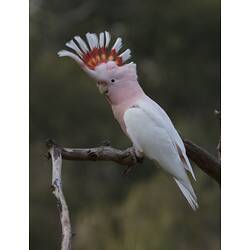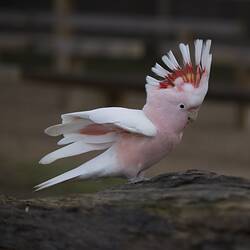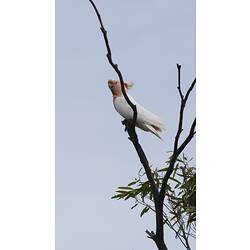General Description
A cockatoo distinguished by its soft pink face and underparts and its large white crest, which when raised shows a bright reddish pink bar with an orange stripe through it. Its back, wings and tail are white. In flight its underwing and tail are also pink. Body size 35 to 40 cm.
Biology
Major Mitchell Cockatoos occur in pairs or small flocks and occasionally in many hundreds when food is abundant. They feed mostly on seeds on the ground or in the foliage of shrubs and trees but will also gouge insect larvae (grubs) out of branches. Sedentary in areas with sufficient water, but nomadic in drier areas. Lays 2 to 4 white eggs on the decaying debris at the bottom of a large tree hollow, usually a Eucalypt close to a creek line. Named after one of Australia's early explorers.
Distribution
Widely distributed across arid and semi-arid inland areas of Australia.
Habitat
Dry inland areas usually along tree-lined watercourses, Eucalypt or Desert Oak woodlands and Acacia shrublands.
More Information
-
Animal Type
-
Animal SubType
-
Brief Id
Beautiful pink and white cockatoo with a white crest with a bright pink and orange stripe when raised.
-
Colours
White, Pink, Yellow, Red
-
Maximum Size
40 cm
-
Habitats
-
Diet
Omnivore
-
Diet Categories
Seeds, Insects
-
Endemicity
-
Commercial
No
-
Conservation Statuses
CITES: Trade restrictions (Appendix II), FFG Threatened List: Critically Endangered, EPBC Act 1999: Endangered, IUCN Red List: Least Concern
-
Taxon Name
-
Common Name
Major Mitchell's Cockatoo
-
Kingdom
-
Phylum
-
Subphylum
-
Class
-
Order
-
Family
-
Genus
-
Species Name
leadbeateri



















